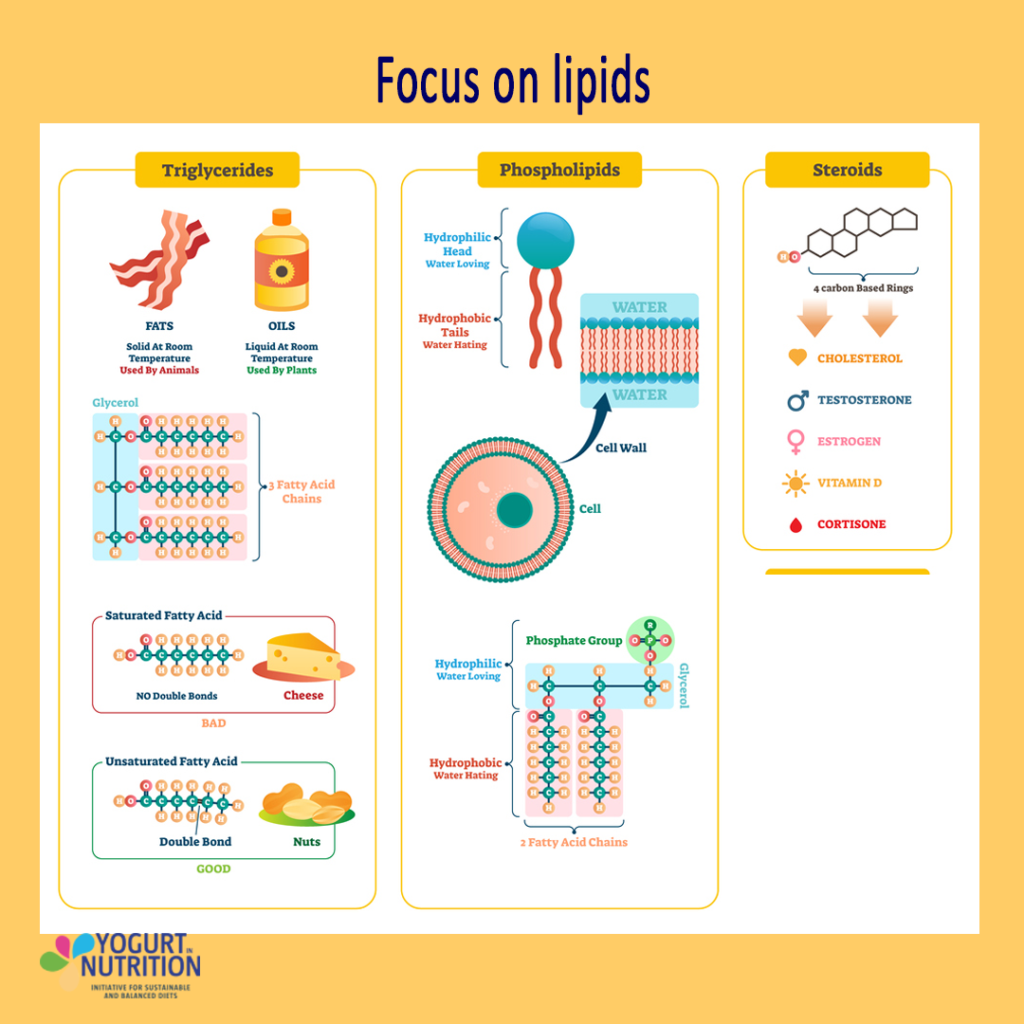Lipids are one of the 3 macronutrients in the diet. They are essential for the proper functioning of the body. Let’s focus on them.
What are lipids?
Lipids, also commonly referred to as fats, are compounds that perform a variety of functions in the body such as structural composition, energy storage or hormone production. Most of the lipids found in food can be divided into three main groups: Triglycerides, phospholipids and steroids (1,2,4).

- Triglycerides are composed of 3 fatty acids linked to a molecule of glycerol. They are the main form of lipid storage in adipocytes.
- Phospholipids are composed of 2 fatty acids linked to a molecule of glycerol with a phosphate group. They are essential components of cell membranes as they provide permeability, fluidity and elasticity.
- Steroids include cholesterol and its derivatives. Cholesterol is a precursor for the synthesis of hormones such as oestrogen or testosterone, and bile acids which help with the digestion of fat and vitamin D. It is also an integral part of cell membranes. 30% of the cholesterol in the body comes from the diet, the rest is synthesized by the body. Cholesterol is transported around the body by lipoproteins. Low density Lipoproteins (LDL) transport the cholesterol to the organs and High-Density Lipoproteins (HDL) transport it to the liver to be excreted. A high level of LDL can increase cardiovascular diseases risk.
Fatty acids are the components of triglycerides and phospholipids, and they can be divided into 2 categories: saturated and unsaturated fatty acids.
- In saturated fatty acids, no more hydrogen atoms can be added. It is ‘saturated’ in hydrogen atoms, and the molecule is straight.
- In unsaturated fatty acids, there is at least one double bond between 2 carbon atoms so the molecule is not saturated in hydrogen. The double bond naturally bends the molecule. Unsaturated fatty acids can have one or more double bonds dividing them further into mono or polyunsaturated fatty acids.
Most fatty acids can be synthesized by the body when needed. However, there are some fatty acids that the body can’t produce, these are called essential fatty acids. There are 2 kinds of essential poly-unsaturated fatty acids: omega-3 and omega-6.
Roles of fatty acids
Saturated fatty acids are classed according to the length of the carbon chain. Short chain saturated fatty acids have a protective role against colorectal cancer (3). Medium chain ones are easy and quick energy sources for the body and aren’t associated with cardiovascular diseases. Long chain saturated fatty acids are the most abundant in triglycerides and phospholipids, they may be associated with cardiovascular diseases(3,5,7).
Mono-unsaturated fatty acids are used by the body as a source of energy, enzyme substrate, transporter and receptor activity.
Omega-3 poly-unsaturated fatty acids are essential for vision, the nervous system functions and anti-inflammatory processes. Omega-6 fatty acids are essential for blood platelets, the functioning of the immune system and inflammatory processes.
More generally, taste wise, lipids improve the mouthfeel and palatability of food. They also help the absorption of fat-soluble nutrients such as vitamin A, D, E and K.
Dietary recommendations for lipids
Recommendations may vary across countries. However, it is recommended that 30 to 40% of our total energy intake come from fats, with:
- 6-11% being polyunsaturated fat
- no more than 10% coming from saturated fatty acids.
More practically, for an adult (consuming 2000 kcal daily), it means:
- 77 to 88g of lipids daily, including
- ~2 g of omega-3,
- ~9 g of omega-6
- less than 25 g of saturated fats

Sources of lipids
Lipids can be found in a variety of foods from both animal and plant sources. Animal sources include butter, fish, eggs, cheese, full-fat milk or yogurt and plant sources include oils, nuts and seeds (6).
For essential fatty acids most people get enough omega-6 in their diet through vegetable oils. Omega-3 fatty acids can be found in oily fish, nuts and seeds such as flaxseed or walnuts and enriched food products.
Most fatty acids found in dairy products are saturated and mono-unsaturated fats.



